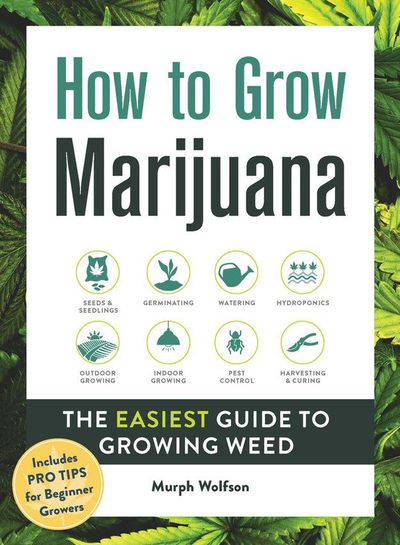Growing for beginners: New how-to book assists new growers

Growing up in Michigan, Murph Wolfson was the only kid who picked vegetables when he went to camp.
He’s always had a love for gardening, and even attained master gardener status as an adult. He previously wrote a book about how house plants benefit health, but recently expanded his writing repertoire into cannabis.
His new book, simply titled “How to Grow Marijuana,” offers 203 pages of advice specifically for beginner growers. Presented in an easy-to-follow format, Wolfson covers topics like seeds, indoor vs. outdoor growing, hydroponics, stages of plant growth and pest control, among other tidbits.
Marijuana is something he confesses he knows quite a bit about.
“It’s an interesting plant,” Wolfson said. “They grow well, but to grow one where you get smokable cannabis is the trick.”
He started experimenting with growing his own pot plants when he was 13. He’s 48 years old now.
He said many modern horticulture and gardening books have been taken over by cannabis – apparently, everyone wants to know more about this very complex plant.
In his book, Wolfson explains that cannabis is a dioecious plant, meaning it has male and female parts. There are male and female plants, as well as hermaphrodites that contain both male and female flowers. Male and female plants must grow close enough together for the male to pollinate the female plants, so they begin to produce seeds.
Most modern cultivators focus only on the female plants and destroy the males and hermaphrodites before they have a chance to pollinate. This is because the flower, or bud, of the female is what is consumed, and unpollinated females produces the strong, potent buds with more THC-rich resin.
Wolfson says male plants, however, are useful for breeding, but in order to grow a potent marketable strain, you have to get rid of the males.
Some growers have rooms where they crossbreed purposely to create seeds, which are then sold for as much as $10 per seed.
Wolfson does not recommend starting to grow with low-quality seeds, and he discusses different ways to germinate seeds in his book.
Some growers choose to clone from a mother/female plant. This means your plants will have the same genetic profile of the mother plant. Take a tiny cutting from the mother, and plant it in soil along with a rooting hormone that stimulates root cells. Wolfson said cloning is how a grower can get the desired strain exactly.
Beginners who think planting a few seeds in a pot and putting it in a closet with a grow light is enough will discover that isn’t going to work very well, says Wolfson. His advice, if possible, is to start growing in a protected place outside, since indoor growing requires extra level of complexity.
But outdoor growing can be risky, depending on the laws where you live. And visible plants can also be targets for thieves.
Another option is a ‘space bucket,’ which creates a micro growing environment with ventilation. Wolfson said you can get very creative with a space bucket.
“Outdoor is amazing – the size is unbelievable – but indoor, you can control everything and produce very strong cannabis,” he said.
The vast majority of what you find on store shelves is grown indoors, he said, because it can be controlled and also produce a larger quantity. Indoor growers can produce good quality bud in a 10-week cycle, staggering production so there is a continuous harvest.
In comparison, outdoor growers may only get one or two harvests a year depending on their size and location.
Newcomers also might not know much about strains, which Wolfson compared to apples.
We know all about galas, honey crisps, cosmic crisps, and so forth, which are specifically bred for certain qualities. The same goes for marijuana where a strain is bred for qualities such as taste, color and potency.
He said sativas strains tend to grow better naturally in a warmer environment, but indicas are more rugged and can survive a night frost.
If you are a more advanced grower, Wolfson dedicates a chapter to hydroponic growing, where you grow without soil. It’s a bit more complicated, but quite do-able he said.
Wolfson is a Florida-based journalist and medical writer by profession. He also owns an editorial services company that works with self-published authors. “How to Grow Marijuana” is published by Simon & Schuster. It can be purchased at local bookstores or online.